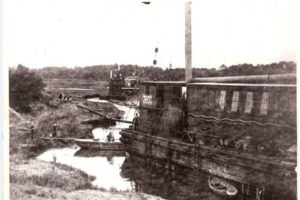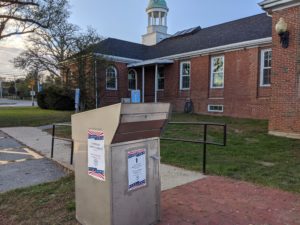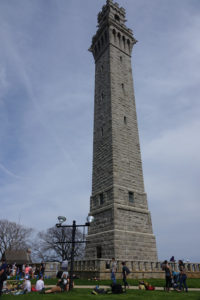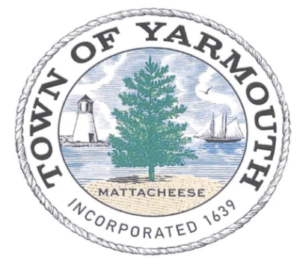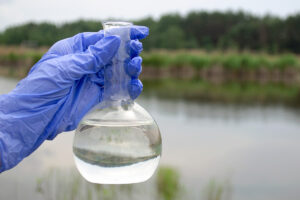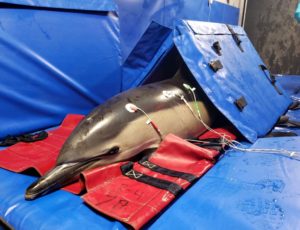CHATHAM – From a dusty racing track around a pond, a mill by a small river, and a marshy natural inlet, over the course of a century the town of Harwich crafted three important harbors opening to Nantucket Sound’s rich fishing grounds and sea routes.
Allen, Wychmere and Saquatucket Harbors are strung along several miles of coastline in Harwich Port, and none of them originally offered full access to the Sound.
“Allen was a trickle, Wychmere was a salt pond with limited inflow and outflow, and Saquatucket was really just the Andrews River meandering from cranberry bogs down to a marsh,” says Tom Leach, who was Harwich’s harbormaster from 1973 to 2012.
Prior to the twentieth century, the center of commercial fishing in Harwich was the Herring River, its shoreline dotted with myriad boat shops, mills and related industries.
“Harwich Port had piers jutting out into the Sound,” says Leach, “from where fishing vessels launched, headed for the Grand Banks.” These wharves facilitated a shipping trade for a village that had no deepwater harbor until 1905.
WYCHMERE
The first harbor dredging effort was focused on Wychmere, located between Allen and Saquatucket and bordered by Snow and Harbor Roads. In the1880s, a track for horse-drawn two-wheeled racing carts called “sulkies” looped around what was then known as Salt Pond, crossing a dike that had been erected over the small stream that led from the pond to Nantucket Sound. For four or five years sulky racing was a popular pastime for Harwich residents, but the Sunday race times conflicted with local church services and the racers suffered their fair share of accidents.
“It must have been a well-organized production,” says Leach, an avid historian on Harwich’s harbors, “since even the New York Times published an article lamenting the end of Salt Pond racing.”
By 1887, the track was gone and the canal into Salt Pond had been re-opened just enough to allow skiffs to sail in and out. Residing near a briny little pond complete with hordes of no-see-ums wasn’t very tempting, although Captain Rinaldo Eldridge did own and operate a hotel, The Sea View House, which was perched on an overlook near the road. He was one of many locals who supported opening up the harbor to Nantucket Sound.
“Salt Pond was brackish, with rotting seaweed,” says Leach. “There was a terrible odor from the pond, so Eldridge’s argument was that dredging could possibly flush the pond water out and freshen the place up.”
By this point, a group of wealthy gentlemen from New York had purchased the nearby Snow Inn and much of the land surrounding the pond. They formed a “syndicate” and used their influence to encourage the state to dredge a deeper channel into the harbor. They knew that if they could get Salt Pond open, they would be able to see a return on their investments, which included transportation and commerce in addition to real estate.
The syndicate hired a Harwich entrepreneur and engineer named Benjamin Bee to draw up a sketch of the proposed canal project and sent it to the Massachusetts Harbor & Land Commission. By 1905, the new harbor, including a granite jetty on the West side of the channel, was built and christened “Wychmere” (“salt lake”) by the syndicate.
“Within five years a considerable fishing fleet of shoal draft catboats were calling ‘Wychmere Harbor’ home,” says Leach.
ALLEN
The westernmost harbor in town, Allen Harbor, was originally called Gray’s Pond or Oyster Pond and was quite shallow, with only a narrow inlet leading to the ocean.
“It was basically just a place to get a skiff into,” says Leach.
The John Allen family owned the surrounding land from the 1750s and built two houses very close to the inlet, which became known as “Allen Harbor.” Initially dredged in 1926, over the years the harbor has improved into a full-service facility.
In the early part of the twentieth century, a man named Donald Dodge had a small boat shop there, which became known as “Allen Harbor Marine Service.” Rupert Nichols Sr., his brother-in-law, began working with him in 1928. He eventually bought the business, and was succeeded by his son, Rupert ‘Ren’ Nichols, Jr. Currently, Allen Harbor Marine Service is run by Craig LeBlanc who took over after Ren passed away in 2014. In addition to being a full-service marine operation it still offers deepwater access to Nantucket Sound.
“The entire basin was dredged again in 2012,” says Leach, “and the town of Harwich has worked tirelessly at Allen Harbor to improve boat slips for both commercial fishing and recreational vessels.”
SAQUATUCKET
Over the past year, Harwich has undertaken a significant overhaul of Saquatucket Harbor, the last of the three. New docks and pilings and 11 additional slips have been added, with a handicap-accessible boardwalk, new offices, and a snack bar. Heinz Proft, the town’s Director of Natural Resources, feels it is a huge improvement.
“We are the Cape’s largest municipal marina facing Nantucket Sound, and this development is a major step forward,” he says.
The harbor is named for the Saquatucket, one of the area’s Native American groups (part of the Wampanoag Tribe), and the busy harbor was once a stream called Andrews Creek or River, for local farmer Andrew Clarke, who used salt hay from the marsh to feed his sheep. A watermill was built on one of its feeder brooks, Carding Machine Brook, in 1820.
In the early twentieth century a small bridge was constructed over the creek “not more than 500 feet distant from the point where the said creek flows into Vineyard Sound,” according to a Harwich Authorization Act in 1907.
Not much changed until 1963, when Richard Wales, then Chairman of the Waterways Commission, took up the cause.
“Wales really loved the town,” says Leach. “He really pushed for the harbor to be built.”
Wales succeeded in getting the Commonwealth of Massachusetts, the U.S. Coast Guard and the Army Corps of Engineers to come aboard.
“The project cost over $2.5 million,” says Leach. “And we managed to work it out that the town only paid around 10 percent of the costs. So we got an amazing harbor that lasted for four decades for around $250,000.”
Saquatucket Harbor opened as a municipal marina in 1970, and a few years later the Bourne House, which had been used as a dormitory for Snow Inn waitresses, was relocated to the property, turned to face the water, and refashioned by the Brackett Family into Brax Landing Restaurant.
The newest harbor project focused on changing the layout of the entire property.
“We replaced the docks, rebuilt the boat ramp and created a new town pier,” says Leach, whose tenure as harbormaster began soon after Saquatucket first opened as a commercial entity.
“Development is a puzzle you have to work out,” says Leach. “We all worked toward the new Saquatucket, but it almost takes you by surprise, everything that was accomplished.”
Leach, succeeded by current Harbormaster John Rendon, says the good news is that fishermen weren’t “thrown under the bus.”
“John is very supportive of the fishing industry,” he says. “The bulkhead is still available to them, and there are excellent slips for the commercial guy which is important because the fishing fleet is not insignificant to our town.”
Harwich’s three harbors support roughly 35 commercial fishing boats, 15 charter boats, a Nantucket ferry service, harbor cruises, and hundreds of recreational and transient boaters — “with a fascinating history behind it all,” says Leach.
By LISA CAVANAUGH, Cape Cod Commercial Fishermen’s Alliance




